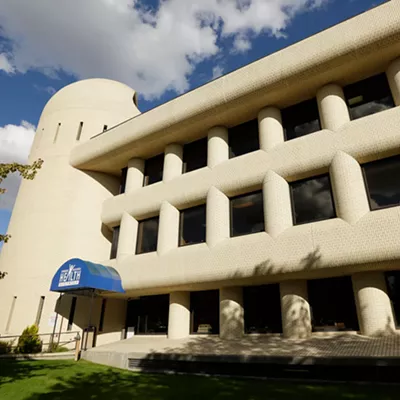After more than two years of preparation, Spokane Regional Health District plans to move its opioid treatment program later this year.
Opened in 1990, the program currently operates out of the health district's main building north of the Spokane River, providing regular doses of methadone or buprenorphine to people addicted to opioids.
Moving to the building at 312 W. Eighth Ave. — near Providence Sacred Heart Medical Center — will allow the staff to offer more services to patients and will expand access to all who need the medication-assisted treatment, says Misty Challinor, treatment services division director at the health district.
The health district pays about $34,000 a month to rent the new space, which was owned by Spokane County until March 2022. The health district, which began paying rent in October, is run by a local health board with elected officials and health care representatives approved by the county commissioners.
While rent for the 25,000-square-foot space is directly paid by taxpayers, all of the opioid treatment program costs (including rent) are recouped by reimbursements from Medicaid, Medicare, private insurance and out-of-pocket charges to patients.
Spokane County sold the building in March 2022 to a company called JP Spokane VIII, which is owned by Texas-based Jaffa Parks, a real estate investment company that owns multiple Spokane properties and is based out of a mobile home park in Austin, according to county records.
Previous tenants moved out after the sale, including a detox program run by Spokane Treatment and Recovery Services, which had to close its withdrawal management beds in the building in May last year after rent increases.
The district made upgrades to the space, including new paint and renovations to ensure the dispensing area will meet pharmacy and Drug Enforcement Administration guidelines, Challinor says.
After the district gets its certificate of occupancy, which could happen by the end of this month, the Washington State Department of Health and other licensing agencies will ensure it's ready to go.
It's been a long time coming, says Challinor. When she started with the district 15 years ago, the opioid treatment program regularly served about 200 patients. As it grew, more space was needed.
Currently, every day but Sunday, 500 to 600 people arrive at the health district building to get their dose starting at 5:15 am, which lets people get to work or school on time. Participants wait their turn in chairs in the building's large main-floor foyer, overflowing from the distribution area.
Because of the space limitations for patients and staff — there aren't more offices to put new hires in — the program has held steady at about 1,100 patients in recent years, Challinor says.
"It's not because the opioid crisis has plateaued," Challinor says. "We have a limit on how many staff we can bring in to provide services."
The program hasn't been able to hire ready-to-go positions such as a resource navigator, who can help participants with everything from resume building to signing up for a bus pass. The new building will have space to finally hire that person as well as a psychiatric nurse practitioner who can prescribe other medications for patients who need them, Challinor says.
Other services like mental health counseling could also expand in the new space.
TRANSPORTATION, NEIGHBORHOOD CONCERNS
One of the immediate concerns that Spokane City Council member Lori Kinnear had when she recently learned about the plan to move the program was how patients would get there.
While there used to be a bus stop right in front of the building, the closest stop is now about a block-and-a-half away. However, Challinor says the district hopes to work with Spokane Transit Authority to get the stop moved back in front of the building.
Unlike the current location, the new space also has enough parking for all of the staff, Challinor says, in addition to about a dozen parking spaces for patients.
Kinnear also wondered whether the move had anything to do with negative feedback from the district's Kendall Yards neighbors. A fence with three gates that have been locked for years blocks pedestrians from accessing My Fresh Basket grocery store from the health district property.
"Are we now marginalizing people based on their wanting to get clean and sober?" Kinnear asks. "What is the message you're delivering by putting this fence up? I don't know the answer to that."
Challinor says she hasn't heard concerns from Kendall Yards and that the neighborhood hasn't been part of the conversation to move. Instead, she says the motivation is purely coming from within the district, which hopes to better serve those struggling with substance use disorder.
Neighbors of the new space will get the chance to learn more at a community meeting that will be organized by the state Department of Health, possibly early this summer, Challinor says.
As the director of the program, Challinor is well aware of the misconceptions people have about its participants, and she says that telling an addict that going cold-turkey is the only way to quit is like telling a diabetic to just make more insulin.
"People are coming to us to better their lives," Challinor says. "The likelihood of it being someone that you know or your neighbor is very probable, because opioid use disorder doesn't differentiate."
Opiates and opioids, the family of drugs including heroin, morphine, hydrocodone, oxycodone and fentanyl, are particularly hard to quit because the substances physically alter brain chemistry over time. With the brain seeking more of the happy endorphins the drugs produce, opiate addicts not only build up a tolerance, but also require a much higher baseline just to feel "normal," let alone high.
Medication-assisted treatment helps break the cycle of seeking the next dose and is an effective strategy for many people, Challinor says.
Participants in the program have to show up regularly (at first daily, then as little as two times per month after earning take-home doses over time), attend counseling, keep their take-home doses in a locked container, report any medical changes, and submit to random drug and alcohol testing.
"It's helping them to sustain that feeling of normalcy so they can go to work, they can go to school, they can raise their family, they can be a productive member of society, whatever that looks like for them," Challinor says. "It's really about meeting the patient where they're at. It's not about enabling, it's really about helping people." ♦
























